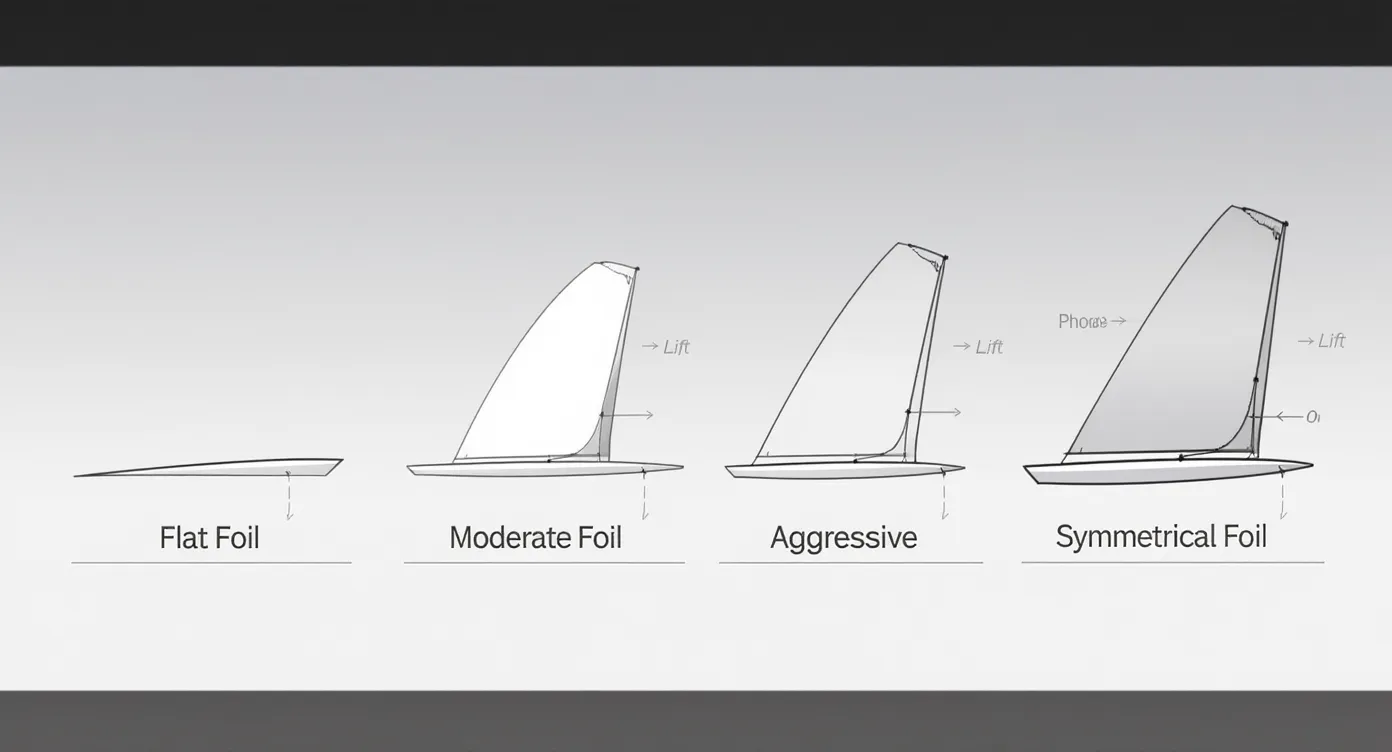You're looking at two fins that look almost identical. Same size, same template, same brand. But one has a different foil, and surfers swear one feels completely different in the water. You're confused. Why does foil matter so much?
Here's the thing: foil is one of the most misunderstood parts of fin design. Most surfers don't even know what it is. But it's the difference between a fin that feels locked-in and responsive versus one that feels mushy and slow.
Let's break down what foil actually does and why it matters for your surfing.
What Is Fin Foil?
Fin foil is the cross-sectional shape of your fin—basically, if you sliced your fin in half from base to tip, the shape you'd see is the foil.
Think of it like an airplane wing. An airplane wing is curved on top and flatter on the bottom. That shape creates lift. Your fin foil works the same way. The shape of your fin creates lift in the water, which affects how your board performs.
Most fins are thicker in the center and taper toward the edges. But the exact curve and thickness varies. That variation is what creates different foil types, and each one performs differently.
The Main Foil Types
There are several common foil shapes, and each one has a specific purpose.
Flat Foil
A flat foil is relatively flat across the top and bottom. It's simple and direct. Flat foils generate less lift, which means they're faster and looser. You get less hold but more speed and maneuverability. Good for smaller waves where you need to generate your own speed.
Moderate Foil (50/50)
This is the middle ground. It's curved on both sides, but not aggressively. It balances speed and hold. You get decent drive without sacrificing too much maneuverability. This is why so many all-around fins use a moderate foil—it works in most conditions.
Aggressive Foil
An aggressive foil is curved more on the top and flatter on the bottom. It generates more lift, which means more hold and drive. Your board feels locked-in and stable. The trade-off? It's slower and less maneuverable. Good for bigger, more powerful waves where you need hold.
Symmetrical Foil
A symmetrical foil is curved equally on both sides. It's neutral and balanced. You get consistent performance in different conditions, but it doesn't excel in any one area. It's versatile but not specialized.
How Foil Affects Your Surfing
Now that you know what foil is, here's how it actually changes the way your board feels.
Speed and Drive
More aggressive foils create more lift, which means more drive. Your board accelerates faster and maintains speed through turns. Flat foils are faster in a different way—they're looser and easier to maneuver, which lets you generate speed through technique rather than fin design.
Hold and Stability
Aggressive foils stick into the wave. You feel locked-in and stable, especially in bigger, more powerful waves. Flat foils don't stick as much. You feel looser and more responsive, which is great for small waves but sketchy in big, hollow waves.
Turning and Maneuverability
Flat foils turn quicker and easier. You can make sharp, snappy turns without much effort. Aggressive foils require more pressure to turn, but when you do turn, you maintain more drive. Moderate foils split the difference.
Wave Conditions Matter
In small, weak waves, you want a flatter foil. You need speed and maneuverability. In bigger, more powerful waves, you want a more aggressive foil. You need hold and stability. In medium waves, a moderate foil works for almost everything.
Foil and Your Surfing Style
Your surfing style matters too. Different surfers prefer different foils based on how they surf.
Power Surfers
If you're the type who drives hard through turns and loads up on the fins, you want an aggressive foil. You need that hold and drive to support your style.
Playful Surfers
If you like quick turns and loose, flowing movements, go with a flatter foil. You want responsiveness over hold.
All-Around Surfers
If you surf different waves and want one setup that works everywhere, a moderate foil is your friend. It's not the best in any one condition, but it's solid in all of them.
The Real Problem: Knowing What Foil You Actually Have
Here's what nobody tells you: most surfers don't know what foil their fins have. You buy a fin because it looks good or because a pro surfer uses it. You don't actually know if the foil matches your style or the waves you're surfing.
You try a fin with an aggressive foil in small waves and it feels mushy. You try a flat foil in big waves and it feels sketchy. You're not sure if it's the foil, the template, the size, or something else entirely.
The challenge is tracking what actually works. You need to remember: "That aggressive foil felt locked-in in 6-foot waves." Or "That flat foil was perfect for 2-foot mush." But most surfers just grab whatever fin is in their quiver and hope it works.
This is where having a tool that tracks your fin performance makes all the difference. Instead of guessing, you'd know exactly which foil worked best in which conditions. You'd remember: "Aggressive foil in overhead waves = locked-in and stable." Or "Flat foil in small waves = fast and responsive."
Stop Guessing Your Foil Setup
The truth is, foil matters. A lot. But only if you actually know what you're using and how it performs in different conditions.
FinFinder helps you track this. Log your sessions, note which fins you used and what foil they had, and the platform learns what actually works for your style and the waves you're surfing. When you're standing in the shop next time, you won't be guessing. You'll know exactly which foil to grab.
Get personalized fin recommendations based on real data from your own surfing. No BS, just what actually works for you.
Helpful Resources
Ready to Find Your Perfect Fins?
Use our expert fin recommender tool to get personalized suggestions based on your needs.
Try Fin Recommender


